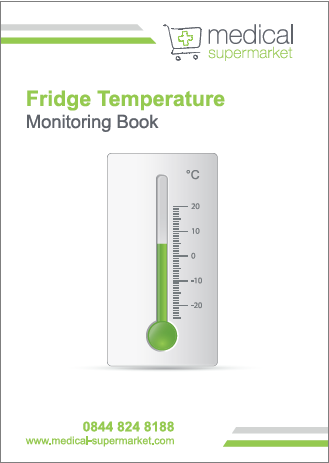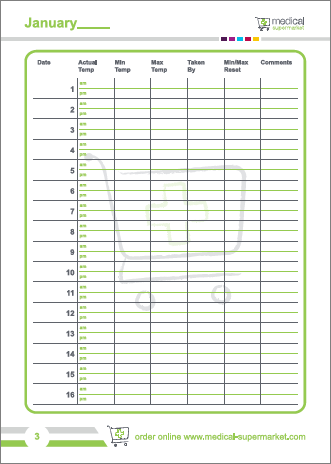Grab your free fridge temperature monitoring book with your next medical supplies order.
We offer all surgeries who trade with us a free fridge temperature monitoring book. To request your free fridge book please order one with your next medical supplies order. The product code is MED/FRI/001 or click the link below. Alternatively you can download one today by clicking here
 Request your Free Fridge Temperature Monitoring Book
Request your Free Fridge Temperature Monitoring Book
To find out why you need to record vaccine fridge temperatures, please read the following information:
Monitoring refrigerator temperatures (daily temperature recording)
We offer all surgeries who trade with us a free fridge temperature monitoring book. To request your free fridge book please order one with your next medical supplies order. The product code is MED/FRI/001 or click the link below. Alternatively you can download one today by clicking here
 Request your Free Fridge Temperature Monitoring Book
Request your Free Fridge Temperature Monitoring BookTo find out why you need to record vaccine fridge temperatures, please read the following information:
Monitoring refrigerator temperatures (daily temperature recording)
- The designated vaccine supervisor or their deputy is responsible for ensuring all staff dealing with the storage of the vaccines and daily temperature recording are competent in reading and resetting the type of maximum / minimum thermometer used in the practice/ clinic/unit.
- In all areas where vaccines are stored there should be a procedure for daily recording of refrigerator temperatures. A copy of this procedure should be kept beside the refrigerator and be readily available for reference.
- The current, maximum and minimum temperatures should be monitored as a minimum on a daily basis on all working days and recorded legibly. After each recording the thermometer memory should be cleared. A standard temperature monitoring record should be used. Temperature records relating to a particular refrigerator should be kept close to that refrigerator (but not inside) for ease of reference and should be clearly identified as relating to that appliance. A separate temperature record should be kept for each refrigerator. The use of whiteboards as a method of logging results is not acceptable. Electronic records are acceptable provided they capture all of the recommended information.
- It is good practice to record the temperature at a similar time each day e.g. first thing in the morning before the refrigerator door is opened for the first time. This will allow review of trends in results recorded; help highlight any changes in temperatures recorded and deviation in refrigerator performance. Any trend of increasing or decreasing temperatures within the recommended range should be investigated before problems occur.
 It is also good practice to record any activity which may affect the temperatures recorded e.g. tidying, restocking, cleaning, defrosting at the time it takes place.
It is also good practice to record any activity which may affect the temperatures recorded e.g. tidying, restocking, cleaning, defrosting at the time it takes place. - The maximum/minimum thermometer should be re-set by clearing the thermometer memory after each reading. To ensure the reset has been carried out correctly, the maximum, minimum and current temperatures should be checked again and if the thermometer has been correctly reset these should all show the same (current) temperature.
- It is good practice to reset the thermometer at the end of a clinic if the refrigerator door has been opened on several occasions or if the refrigerator has been re-stocked, cleaned or defrosted. Resetting should be carried out once the current temperature reading has returned to within the recommended range.
- If temperatures are noted to be outwith the recommended range then this should be recorded along with action taken to resolve the issue. For example, if defrosting the refrigerator has taken place or the door has been left open for a period of time e.g. to re-stock the refrigerator, this should be recorded in the comments column.
- The individual checking the temperature should sign the recording sheet.
Retention of temperature record
- Temperature records for vaccine refrigerators are classed as NHS administrative records. NHS HDL (2006) 28 provided NHS Boards with guidance on the retention and disposal of administrative records. This guidance does not specifically mention temperature records for vaccine refrigerators. In line with the recommendation in this HDL related to Quality Assurance records it is recommended that temperature records for vaccine refrigerators should be kept for a period of 12 years since the last entry. Records should be stored and archived as per local NHS Board policy.
- Where automatic paper chart recorders are used to monitor temperatures, these should be replaced as soon as the chart is full. The date and time the chart was started and finished should be clearly stated on the chart and any observations or actions in relation to temperatures outside of the range clearly documented. The chart should also be retained for a period of 12 years.















